July 2019 lunar eclipse
A partial lunar eclipse occurred on the 16 and 17 July 2019. The Moon was covered about 65% by the Earth's umbral shadow at maximum eclipse.
| Partial Lunar Eclipse July 16, 2019 | |
|---|---|
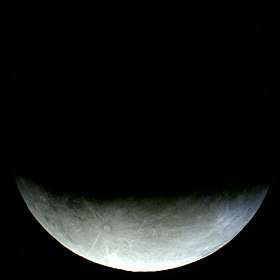 Near greatest eclipse from Tilehurst, England, 21:30 UTC | |
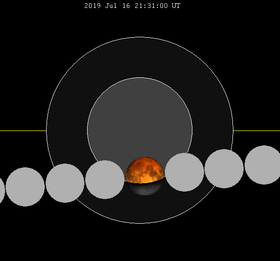 This chart shows the right-to-left hourly motion of the moon through the earth's shadow. | |
| Series (and member) | 139 (22 of 81) |
| Duration (hr:mn:sc) | |
| Partial | 2:57:56 |
| Penumbral | 5:33:43 |
| Contacts | |
| P1 | 18:43:53 UTC |
| U1 | 20:01:43 |
| Greatest | 21:30:44 |
| U4 | 22:59:39 |
| P4 | 0:17:36 |
This was the last umbral lunar eclipse until May 2021.
Visibility
It was visible over most of Asia, Australia, Africa, Europe, and South America.[1]
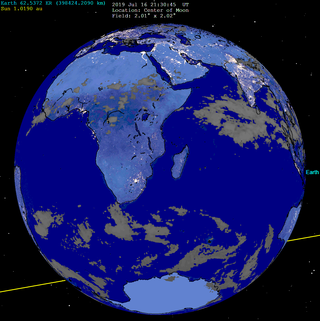 |
 Visibility map |
Gallery
 Hefei, China, 19:56 UTC
Hefei, China, 19:56 UTC Mariupol, Ukraine, 20:25 UTC
Mariupol, Ukraine, 20:25 UTC Tashkent, Uzbekistan, 21:05 UTC
Tashkent, Uzbekistan, 21:05 UTC Moscow, Russia, 21:11 UTC
Moscow, Russia, 21:11 UTC Novate Milanese, Italy, 21:17 UTC
Novate Milanese, Italy, 21:17 UTC Bandung, Indonesia, 21:20 UTC
Bandung, Indonesia, 21:20 UTC.jpg) Farasan Island, Saudi Arabia, 21:25 UTC
Farasan Island, Saudi Arabia, 21:25 UTC Munich, Germany, 21:36 UTC
Munich, Germany, 21:36 UTC.jpg) Manuel B. Gonnet, Argentina, 21:43 UTC
Manuel B. Gonnet, Argentina, 21:43 UTC.jpg) London, UK, 21:47 UTC
London, UK, 21:47 UTC Sayada, Tunisia, 21:55 UTC
Sayada, Tunisia, 21:55 UTC.jpg) Krško, Slovenia, 22:19 UTC
Krško, Slovenia, 22:19 UTC_1.jpg) Logroño, Spain, 22:32 UTC
Logroño, Spain, 22:32 UTC Banjarmasin, Indonesia, Near Moonset, 22:17 UTC
Banjarmasin, Indonesia, Near Moonset, 22:17 UTC
Related eclipses
Eclipses of 2019
Lunar year series
| Lunar eclipse series sets from 2016–2020 | ||||||||
|---|---|---|---|---|---|---|---|---|
| Descending node | Ascending node | |||||||
| Saros | Date | Type Viewing |
Gamma | Saros | Date Viewing |
Type Chart |
Gamma | |
| 109 | 2016 Aug 18 |
Penumbral |
1.5641 | 114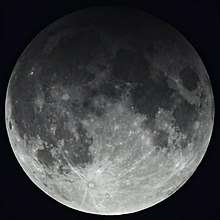 |
2017 Feb 11 |
Penumbral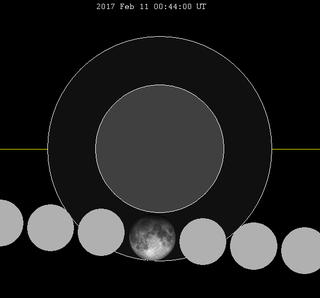 |
-1.0255 | |
119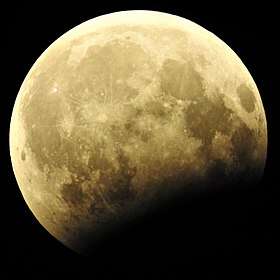 |
2017 Aug 07 |
Partial |
0.8669 | 124 |
2018 Jan 31 |
Total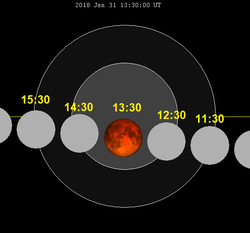 |
-0.3014 | |
129_(43696968392)_(cropped).jpg) |
2018 Jul 27 |
Total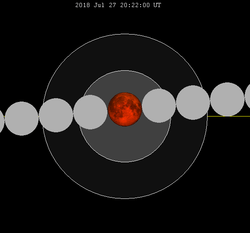 |
0.1168 | 134_(cropped).jpg) |
2019 Jan 21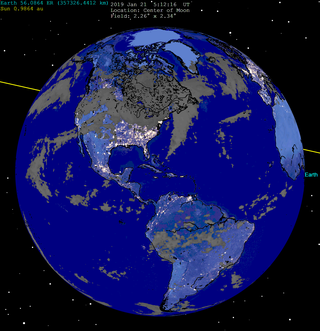 |
Total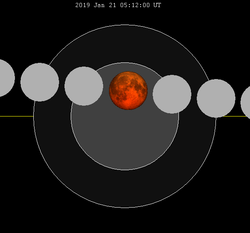 |
0.3684 | |
139 |
2019 Jul 16 |
Partial |
-0.6430 | 144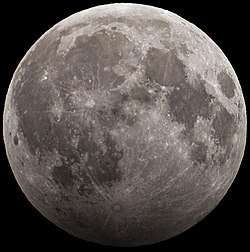 |
2020 Jan 10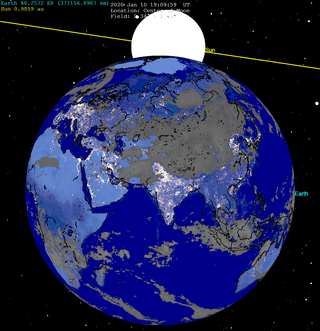 |
Penumbral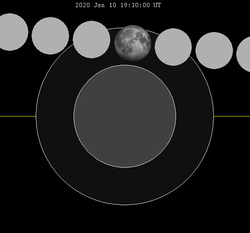 |
1.2406 | |
| 149 | 2020 Jul 05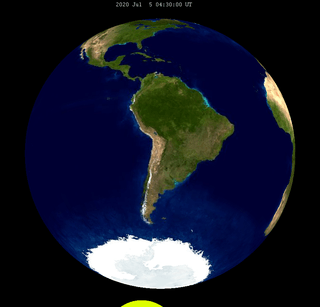 |
Penumbral |
-1.3639 | |||||
| Last set | 2016 Sep 16 | Last set | 2016 Mar 23 | |||||
| Next set | 2020 Jun 05 | Next set | 2020 Nov 30 | |||||
Saros series
It is part of Saros cycle 139.
Half-Saros cycle
A lunar eclipse will be preceded and followed by solar eclipses by 9 years and 5.5 days (a half saros).[2] This lunar eclipse is related to two total solar eclipses of Solar Saros 146.
| July 11, 2010 | July 22, 2028 |
|---|---|
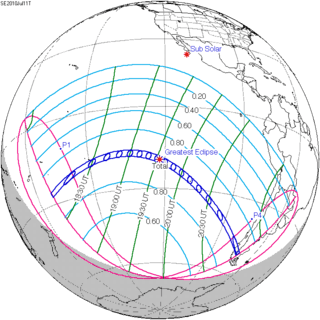 |
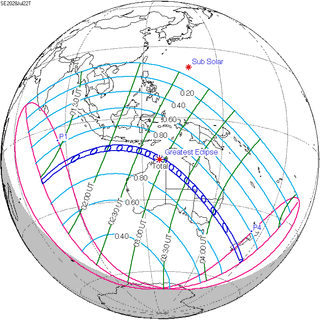 |
Saros cycle
Lunar Saros series 139, repeating every 18 years and 11 days, has a total of 79 lunar eclipse events including 27 total lunar eclipses.
- First Penumbral Lunar Eclipse: 1658 Dec 09
- First Partial Lunar Eclipse: 1947 Jun 03
- First Total Lunar Eclipse: 2073 Aug 17
- First Central Lunar Eclipse: 2109 Sep 09
- Greatest Eclipse of Lunar Saros 139: 2199 Nov 02
- Last Central Lunar Eclipse: 2488 Apr 26
- Last Total Lunar Eclipse: 2542 May 30
- Last Partial Lunar Eclipse: 2686 Aug 25
- Last Penumbral Lunar Eclipse: 3065 Apr 13
gollark: https://ark.intel.com/products/88197/Intel-Core-m5-6Y57-Processor-4M-Cache-up-to-2_80-GHz
gollark: There exists a comparison table.
gollark: m5 sounds awful.
gollark: Either that or use the tablet... to buy a better device.
gollark: Well, \@everyone manages to be backslash-escaped.
See also
- List of lunar eclipses and List of 21st-century lunar eclipses
References
- "Lunar eclipse july 2019 timing of all countries". bindassnews.com.
- Mathematical Astronomy Morsels, Jean Meeus, p.110, Chapter 18, The half-saros
External links
- Partial Lunar Eclipse 2019
- Saros cycle 139
- Hermit eclipse: 2019-07-16
- 2019 Jul 16 chart: Eclipse Predictions by Fred Espenak, NASA/GSFC
This article is issued from Wikipedia. The text is licensed under Creative Commons - Attribution - Sharealike. Additional terms may apply for the media files.
